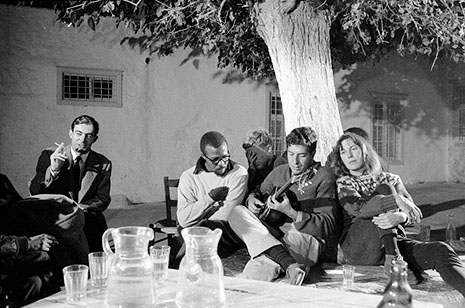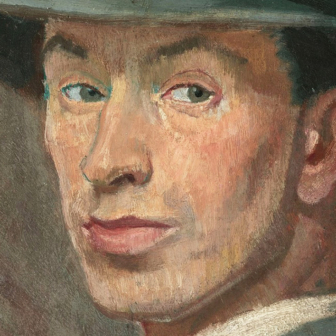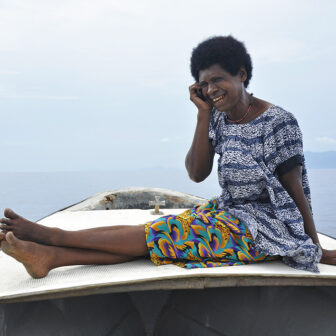“THERE it went! – Our last little bit of capital, our going back to civilisation money...” So Charmian Clift fretted when she watched her husband George Johnston hand over a large number of drachma notes to buy a house on the Greek Island of Hydra in 1956. Whereas today’s expatriates fly back and forth between home and away with ease, Clift’s commitment to Hydra meant that a return to Australia, “to civilisation,” would always be difficult and perhaps impossible.
Clift was in her mid thirties at the time, and she and Johnston had been overseas for some five years as they pursued careers and writing in London and then on another Greek island, Kalymnos. Insofar as she was remembered in Australia, it was as likely to be for her scandalous relationship with Johnston – she became pregnant while he was still in a previous marriage – as for the three novels they had jointly authored. Buying the house by the well was a bid by Clift and Johnston to find the time to write from a sunny rooftop overlooking the Aegean Sea.
Clift’s first sole-authored book, Mermaid Singing (1956), appeared the same year as they bought the house. It captured the couple’s time on Kalymnos, which had also inspired their co-authored novel The Sponge Divers (1955). On Hydra, Clift kept on with writing her novels, but she also wanted to develop the style of travel writing she had begun with Mermaid Singing. Peel Me a Lotus (1959), her “Hydra book,” moves across the territory of novel, travel writing, literary essay and memoir.
Clift certainly felt she had found the good life on Hydra in the 1950s despite the lack of money and amenities. She luxuriated in the outdoors and a life that required physical effort – then, as now, no cars or bikes were permitted on the island. She and Johnston were at the centre of a group of well-read and creative expatriates – some of whom, like Canadian poet Leonard Cohen, and Australian artist Sidney Nolan, were beginning to make international reputations. Hydra gave her the impetus to explore the travel writing mode to tell her story and she delivered a strong visual picture of the way of life as well as the challenges of being a wife, mother and writer in that environment. We see in Peel Me a Lotus many of the enduring conceits of travel writing: the flight from home, a penchant for risky behaviour, and anxieties about distant friends and family.
In one way Peel Me a Lotus provides a valid starting point for the work of contemporary Australian women travel writers, but Clift’s writerly ambitions mark a point of difference from more recent authors such as Mary Moody, Penelope Green and Margaret Ambrose. Clift is self-consciously literary – reflective, descriptive, poetic, with a novelist’s sense of restraint and form. Her personalised travel experience is a touchstone for today’s writers, but whereas Clift focused on the battle for a productive creative life, Moody, Green and Ambrose emphasise self-discovery and an investment in lifestyle. Gone now are the postwar worries that kept Clift and her friends talking and drinking all night about what it means to be Australian – today’s authors want to know what it means to be French or Italian. They are fans of foreign language, fashion, food, and the style of la dolce vita. Moody, for example, is a self-described classic baby boomer who “had it all” but needs time away from her family and television career. The younger women, Green and Ambrose, want to experience the cosmopolitan allure of European big-city life. Only Ambrose remarks on searching for a cultural experience she feels is missing in Australia: “there is no bohemian equivalent in Australia; we have no group that is collectively called ‘the intellectuals.’” For Ambrose, Paris is the “ultimate fairy-tale” where she dreams of finding fashion and the avant-garde.
Clift’s move to Greece is not then a way of “finding oneself,” as in Moody’s case, or indeed the result of longings for a European language or a particular city as with Green and Ambrose. Life on Hydra was no fairy-tale. Clift and her family struggle with the demands, and temptations, of living among an often tempestuous foreign community in the midst of a traditional Greek culture. She becomes pregnant with her third child and has little money or medical support. But she had always taken risks of one sort or another, and she continued this tendency in Hydra, continually fascinated by the tension between “terror and desire” whether she was giving birth or swimming in a dangerous pool at night below a cave on Hydra:
Sometimes, for a mad moment, when my hand slips on the ladder and the iron rungs suddenly leap above my head and the weeds pour down, or I feel myself being hurled forwards towards those jagged, streaming rocks, the smell rises as though my mouth was stuffed with oozy sponges, and I am filled with something that is terror and desire both... to ride on with the wild horses to the waiting cliff, or to curl up small, close against the scaly rocks, to curl up small and let the wild horses ride over me.
Moody’s bravado is often physical, as is Clift’s, but her risky moments are not recorded with such imaginative resonance. In Au Revoir: Running Away From Home at Fifty (2001) Moody celebrates her ability to jump into new situations, and by her next book, Last Tango in Toulouse (2003) she and her husband have bought a house in the Lot region in France where Moody intends to spend a part of each year. She has an affair with a man in Toulouse and the narrative arc changes. By foregrounding the story of her sexual experience Moody highlights a shift in the genre of women’s travel narratives. A quick contrast of Clift’s textual decorum with Moody’s admissions of infidelity shows the ever-widening gap in the readers’ expectations of what constitutes acceptable disclosure.
GREEN’s risk is of a different order. In When in Rome: Chasing la Dolce Vita (2005) the focus is on the self and her swinging emotions, with sexual encounters adding extra spice rather than driving the narrative forward. She finds her way around Rome on her own, working illegally and searching out opportunities for freelance journalism along the way. She has a six-week sojourn in Australia where, she says, “I can’t work out where I belong, or where I most want to be.” In contrast, Ambrose is conscious of risk, worrying about safety on the Paris Metro or wandering the streets alone, and she is happy with her boyfriend in Australia. Much of her Europe-dreaming takes place in language classes in Melbourne.
It is Moody, who consistently emphasises her status as mother and grandmother, who makes sexual encounters central to her travel experience. In Au Revoir she is quickly welcomed into an expatriate social circle but “once I am well settled in my house in the woods and living a relatively normal day-to-day existence, the thought of sex suddenly dawns on me.” In Last Tango in Toulouse she writes not only about her first affair, but also relives her sexual history, including being raped when a teenager. Her editors, she explains, wanted “more on my feelings about myself – my body image, my sexuality, my thoughts and the reactions to the people I met while living overseas.”
In the final instalment of her successful trilogy, The Long Hot Summer (2005), Moody invokes Anaïs Nin and Clift as fellow writers who had sexual encounters during their foreign travel and included this material in their writing. Moody refers to “the writings of Charmian Clift about her love affairs and her lifelong bond to her husband George Johnston.” But Clift did not write about her affairs in her travel writing, and references to her affairs (the subject of mythology and apparently overstated) were used with caution only in her fiction.
Indeed, the persona on display in Peel Me a Lotus is that of a modern woman with intellectual ambitions who thinks about her family as much as sexual dalliance. Despite her general support for sexual freedom, Clift was quite disapproving, on the page at least, of the sexual activities of other Western travellers. Her own sexuality is subsumed in the picture of the harried housewife and she is acerbic about young men who were “poste-restante, interchangeable, culture-addicted, Europe-sick boys.” Her sensuousness is more apparent in her writing about the physical landscape, the sea in particular, and recalls stories of a younger Clift “star-baking” naked at night on the rocks at Kiama. Now she is part of an expatriate community with a commitment to a creative life, and not part of the bohemian flotsam and jetsam. She is bemused by the American visitor Mrs Knip, who insists on asking the artists “but what are you doing it for?”
Perhaps here is a key difference between Clift and her travel-writing successors. She is “doing it” to fulfil her life-long literary aims. Clift began work as a journalist, became a novelist and then moved into the travel mode before finally becoming a highly successful essayist in Australia in the late 1960s. The more contemporary authors discussed here write in response to the travel experience rather than take the travel experience in order to write. Clift’s biographer, Nadia Wheatley, wrote that Clift’s first book about Greece, Mermaid Singing, failed in part because “the author’s social and political attitudes were far ahead of the times. Forty years after its writing, Mermaid Singing speaks now with a very contemporary voice.” Peel Me a Lotus was subsequently rejected by a number of publishers in the United States (the depiction of American tourists is hardly complimentary) but the book attracted good reviews after it was published by Hutchinson in England, although sales were poor.
DISTANCE, then, worked for Clift stylistically and against her financially. She had a strong idea of the type of travel she wanted to write. She resisted requests for changes from American publishers – “they have turned the book into just another travel story, which I never intended to write.” According to Wheatley, Peel Me a Lotus is “an example of an anti-pastoral in a form of literature that typically follows pastoral conventions. Despite some extraordinarily lyrical depictions of Hydra, the lasting impression of the island is of a searingly hot place full of superficial and vindictive people.” Wheatley goes on to say that Clift focused on the “hardship and ugliness” and did not allow for the “Arcadian experience that makes the reader feel that he or she is taking a vicarious holiday.”
In The Long Hot Summer, Moody, like Clift, resists her works being classified as travelogues and calls them an “intensely personal journal in which I take a long hard look at my life, past and present.” In this context Moody’s editorial experience is instructive – she has a problem using “I” and “me” in Last Tango in Toulouse, so she is told to “tell it from the heart,” with the result that “I wrote about it exactly as I remembered it, the good bits and the bad bits.” Today’s readers who embrace the raw confessional are not likely to be taken aback; witness Green’s conversations in kitchens and bedrooms. Evidently the taste for self-revelation in travel writing has broadened, and readers want to know as much about the author as they do about the restaurants they choose and the details of the menu. This is not quite a politics-free zone – Moody takes up gender issues – but generally it is the fascination with another culture, or oneself, that challenges the travellers to find a way to “be there” but also to be at home. They are networked in a way that Clift could never have imagined.
Moody, Green and Ambrose are all careful to include numerous references to consumables for aspirational readers. In When in Rome, Green zips around Rome from job to job as she tries to carve out her own portion of the good life. She shares with Moody and Ambrose a talent for choosing good-looking friends who can cook fabulous meals or dress stylishly. Moody gives a lot more space to the life of rural France but Green and Ambrose are city dwellers with city careers in Australia – they are keen observers and participants in the popular culture of their chosen cities. Their view is from the streets and television screens, the bars and restaurants. Ambrose’s best moment arrives when an Australian tourist in Paris thinks she looks like a “real” French woman. With more panache and critical prose, Green surveys Roman style: “as I watch the morning crowd pass I decide the average Italian woman wears clothes a bit too tight and pop-tart trashy for my simpler tastes. So why do they make me feel so daggy?” In the 1950s Clift could only turn to the mirror on Hydra and comment ruefully, “I have let myself go.”
The lifestyle-driven references to wine, food, antique markets and shopping are therefore a long way from the drought-stricken Greek island evoked by Clift in the 1950s. Clift’s friends opposed “the rat-race of modern commercialism”, and her readers had to be content with descriptions of the people or passages about Hydra:
it rises in tiers around the small, brilliant, horseshoe-shaped harbour – old stone mansions harmoniously apricot-coloured against the gold and bronze cliffs, or washed pure white and shuttered in palest grey: houses austere but exquisitely proportioned, whose great walls and heavy arched doors enclose tiled courtyards and terraced garden.
Living at a distance, Clift found an oeuvre in her personalised travel stories and a balance between the abstract and the personal that served her well. The Peel Me a Lotus stories are highly constructed accounts that develop characters from her observations. She became expert at inviting the reader in and the crafted rendering of the self is not permitted to overwhelm the prose that brings to life the place and the people. Her skill with dialogue, built up through writing radio scripts and novels, allows the reader to hear the characters as much as see them – readers feel that hers is a truthful account of a Greek island. From that point she is able to advance a broader political or social point. She had, as Johnston noted, the capacity for “widening the intellectual and emotional horizons of ordinary men and women.”
Wheatley may well be right in arguing that Clift presented too much of the grit of daily life to guarantee high sales at the start of the 1960s. Yet, her rendition of life on Hydra is positive and, although this may have been a little forced because she did not have the option of easily returning home, there is equally a strong sense of an emotional and political commitment to her life in Greece. She captures a cultural moment and her books written in Greece are reread for her incisive observations as well as for the lyrical prose. Contemporary writers have successfully taken up some of the conventions of personalised travel found in Clift’s books but they have reoriented the writing to focus on the self (and a stylish self at that). Moody laments in relation to The Long Hot Summer that if she were a “poet or novelist, writing this book would be less difficult.” Clift probably would not agree, but then, she would be starting from a different place. •




